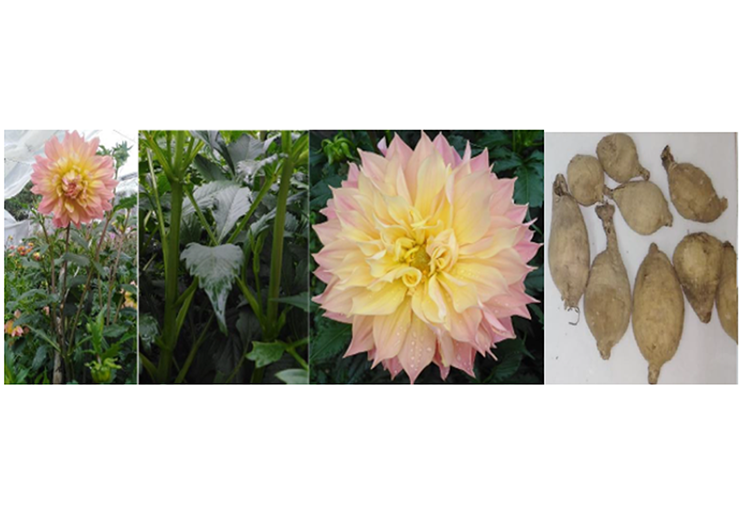Morphological and nutritional description of Yaretzi: a variety of dahlia for cut or potted flower
DOI:
https://doi.org/10.29312/remexca.v16i4.3689Keywords:
Dahlia spp., bioactive compounds, floriphagia, phytogenetic resourcesAbstract
The genus Dahlia (Asteraceae: Coreopsideae), made up of 42 species characterized by their wide diversity in size, shape, and color of their inflorescences, is highly appreciated for ornamental use and nutritional contribution. The aim of this contribution is to disseminate the morphological and nutritional description of Yaretzi, a variety of dahlia suitable for cut or potted flower. The plant of this variety has a stem diameter of 13.6 mm, 11.29 nodes, 5.78 branches, 90.16 days to flowering, 14.75 flowers, 350.86 g of root weight, 6.97 roots, peduncle diameter of 3.4 mm, and capitula (diameter= 112.36 mm, 138.22 ligules and 170 g of weight). Among the main physicochemical characteristics of ligulate flowers are 5.83 °Brix, 7.81% malic acid, 5.01 mg 100 g-1 vitamin C and 0.08 mg 100 g-1 chlorophyll. Likewise, 1.46 mg kg-1 of total anthocyanins, 0.05 mg Eβ-carotene g-1 (total carotenoids), total phenols (31.52 mg GAE g-1), antioxidant capacity (60.63 and 177.42 μmol TE g-1, FRAP, ABTS, respectively), color components (lower and upper part of the ligula) L*= 67.07-73.29, C*= 55.46-53.44, °h= 24.19-23.31. Among the minerals, the high concentration of Fe2+ and Zn2+ stands out, both nutrients are essential for human health. On the other hand, tuberous roots stood out for having around 24% inulin, a carbohydrate with a promising role as a prebiotic. These results contribute to the diversification of the dahlia, an endemic and microendemic phytogenetic resource of Mexico.
Downloads
References
ADS. 2024. American Dahlia Society. https://www.dahlia.org/docsinfo/species-dahlias/list-of-species-dahlias/.
AOAC. 1975. Association of Official Analytical Chemists. Official methods of analysis Washington DC.
Benzie, I. F. and Strain, J. J. 1996. The ferric reducing ability of plasma (FRAP) as a measure of ‘antioxidant power’: the FRAP assay. Anal. Biochem. 239(1):70-76. Doi.org/10.1006/abio.1996.0292.
Craker, L. E. 1971. Postharvest color promotion in cranberry with ethylene. HortScience. 6(2):137-139. Doi.org/10.21273/hortsci.6.2.137.
Cruz-Álvarez, O.; Hernández-Rodríguez, O. A.; Jacobo-Cuellar, J. L.; Ávila-Quezada, G.; Morales-Maldonado, E.; Parra-Quezada, R. Á. and Ojeda-Barrios, D. L. 2020. Nitrogen fertilization in pecan and its effect on leaf nutrient concentration, yield and nut quality. Revista Chapingo Serie Horticultura. 26(3):163-173. Doi.org/10.5154/r.rchsh.2019.10.021.
García-González, O. T.; Cruz-Álvarez, O. y Ojeda-Barrios, D. L. 2024. Raíces tuberosas de dalia, una fuente natural de inulina. Hypatia. 76(1):24-25.
Hernández-Epigmenio, F.; García-Mateos, M. R.; Sosa-Montes, E.; Mejía-Muñoz, J. M.; Fernández-Pavía, Y. L.; Cruz-Álvarez, O. and Martínez-Damián, M. T. 2022. Phenolic profile and nutritional value of Dahlia x hortorum flowers. Revista Chapingo Serie Horticultura. 28(3):161-174. Doi.org/10.5154/r.rchsh.2022.03.004.
Lee, J.; Durst, R. W. and Wrolstad, R. E. 2005. Determination of total monomeric anthocyanin pigment content of fruit juices, beverages, natural colorants, and wines by the pH differential method: collaborative study. J. AOAC Int. 88(5):1269-1278. Doi.org/10.1093/jaoac/88.5.1269.
McGuire, R. G. 1992. Reporting of objective color measurements. HortScience. 27(12):1254-1255. Doi.org/10.21273/hortsci.27.12.1254.
Ordoñez-Santos, L. E.; Hurtado-Aguilar, P.; Rios-Solarte, O. D. and Aria-Jaramillo, M. E. 2014. Concentración de carotenoides totales en residuos de frutas tropicales. Revista Producción + Limpia. 9(1):91-98.
Re, R.; Pellegrini, N.; Proteggente, A.; Pannala, A.; Yang, M. and Rice-Evans, C. 1999. Antioxidant activity applying an improved ABTS radical cation decolorization assay. Free Radic. Biol. Med. 26(9-10):1231-1237. Doi.org/10.1016/S0891-5849(98)00315-3.
Rivera-Espejel, E. A.; Cruz-Alvarez, O.; Mejía-Muñoz, J. M.; García-Mateos, M. R.; Colinas-León, M. T. and Martínez-Damián, M. T. 2019b. Physicochemical quality, antioxidant capacity and nutritional value of edible flowers of some wild dahlia species. Folia Hortic. 31(2):331-342. Doi.org/10.2478/fhort-2019-0026.
Rosas-Romero, R. y Covarrubias-Gómez, A. 2020. El papel del zinc en la salud humana. Revista Médica del Instituto Mexicano del Seguro Social. 58(4):477-485. 10.24875/RMIMSS.M20000073.
Singleton, V. L. and Rossi, J. A. 1965. Colorimetry of total phenolics with phosphomolybdic-phosphotungstic acid reagents. Am. J. Enol. Vitic. 16(3):144-158. Doi.org/10.5344/ajev.1965.16.3.144.
Tomasik, P. 2003. Chemical and functional properties of food saccharides. CRC press. Ed.
Toneli, J. T. C. L.; Mürr, F. E. X.; Martinelli, P.; Fabbro, I. M. and Park, K. J. 2007. Optimization of a physical concentration process for inulin. J. Food Eng. 80(3):832-838. Doi.org/10.1016/j.jfoodeng.2006.07.012.
Toxqui, L.; Piero, A. D.; Courtois, V.; Bastida, S.; Sánchez-Muniz, F. J. y Vaquero, M. 2010. Deficiencia y sobrecarga de hierro: implicaciones en el estado oxidativo y la salud cardiovascular. Nutr. Hosp. 25(3):350-365.
UPOV. 2006. Unión Internacional para la Protección de Obtenciones Vegetales. Código UPOV DAHI Dahlia Cav. Directrices para la ejecución del examen de la distinción, la homogeneidad y la estabilidad. https://www.upov.int/edocs/tgdocs/es/tg226.pdf.

Published
How to Cite
Issue
Section
License
Copyright (c) 2025 Revista Mexicana de Ciencias Agrícolas

This work is licensed under a Creative Commons Attribution-NonCommercial 4.0 International License.
The authors who publish in Revista Mexicana de Ciencias Agrícolas accept the following conditions:
In accordance with copyright laws, Revista Mexicana de Ciencias Agrícolas recognizes and respects the authors’ moral right and ownership of property rights which will be transferred to the journal for dissemination in open access. Invariably, all the authors have to sign a letter of transfer of property rights and of originality of the article to Instituto Nacional de Investigaciones Forestales, Agrícolas y Pecuarias (INIFAP) [National Institute of Forestry, Agricultural and Livestock Research]. The author(s) must pay a fee for the reception of articles before proceeding to editorial review.
All the texts published by Revista Mexicana de Ciencias Agrícolas —with no exception— are distributed under a Creative Commons License Attribution-NonCommercial 4.0 International (CC BY-NC 4.0), which allows third parties to use the publication as long as the work’s authorship and its first publication in this journal are mentioned.
The author(s) can enter into independent and additional contractual agreements for the nonexclusive distribution of the version of the article published in Revista Mexicana de Ciencias Agrícolas (for example include it into an institutional repository or publish it in a book) as long as it is clearly and explicitly indicated that the work was published for the first time in Revista Mexicana de Ciencias Agrícolas.
For all the above, the authors shall send the Letter-transfer of Property Rights for the first publication duly filled in and signed by the author(s). This form must be sent as a PDF file to: revista_atm@yahoo.com.mx; cienciasagricola@inifap.gob.mx; remexca2017@gmail.
This work is licensed under a Creative Commons Attribution-Noncommercial 4.0 International license.


